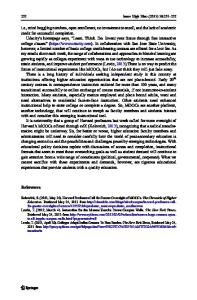High-Performance Emerging Solid-State Memory Technologies
- PDF / 447,594 Bytes
- 9 Pages / 612 x 792 pts (letter) Page_size
- 88 Downloads / 425 Views
High-Performance Emerging SolidState Memory Technologies
Herb Goronkin and Yang Yang, Guest Editors Abstract This article introduces the November 2004 issue of MRS Bulletin on the state of the art in solid-state memory and storage technologies. The memory business drives hundreds of billions of dollars in sales of electronic equipment per year. The incentive for continuing on the historical track outlined by Moore’s law is huge, and this challenge is driving considerable investment from governments around the world as well as in private industry and universities. The problem is this: recognizing that current approaches to semiconductor-based memory are limited, what new technologies can be introduced to continue or even accelerate the pace of complexity? The articles in this issue highlight several commercially available memories, as well as memory technologies that are still in the research and development stages. What will become apparent to the reader is the huge diversity of approaches to this problem. Keywords: solid-state memory, storage technology.
The world seems to have an insatiable appetite for solid-state integrated circuit memory. History shows that any memory density on the Moore’s law curve is only a stepping stone to the next more complex node. Driving this escalation of complexity is the consumer’s need to move from simple mathematical calculations and word processing that required only kilobits of memory to audio and movie downloads needing gigabits of memory. Near-term market demands for applications such as real-time on-demand movie viewing will require memory densities in the multi-gigabit range that can operate with communication devices in the hundreds of megabits range. But, even though the memory industry has kept pace and even facilitated challenging applications, the combination of physical barriers and cost escalation appear to be drawing Moore’s law to a close, as transistors are becoming too small to function properly. Undesirable quantum effects such as electron tunneling through the gate oxide and excessive electric fields arising from small spacings preclude satisfactory operation.
MRS BULLETIN/NOVEMBER 2004
Current integrated circuit memory elements are fabricated in silicon using extremely complex fabrication techniques. The exquisitely controlled interplay of chemical and physical processes that is required to fabricate hundred of millions of transistors and memory elements in a chip no larger than a couple of centimeters on a side is truly one of the wonders of the technological world. Processes that are seemingly incompatible are made to work together in a reproducible and repeatable way to produce chips of such high reliability that they can continuously operate for ten years or more in a temperature range that covers at least from 0°C to 130°C. But these processes—lithography, etching, deposition, etc.—are currently working near their limits of resolution; indeed, moving past the 30 nm node will be rather difficult. At the same time, the fundamental building blocks of int
Data Loading...











